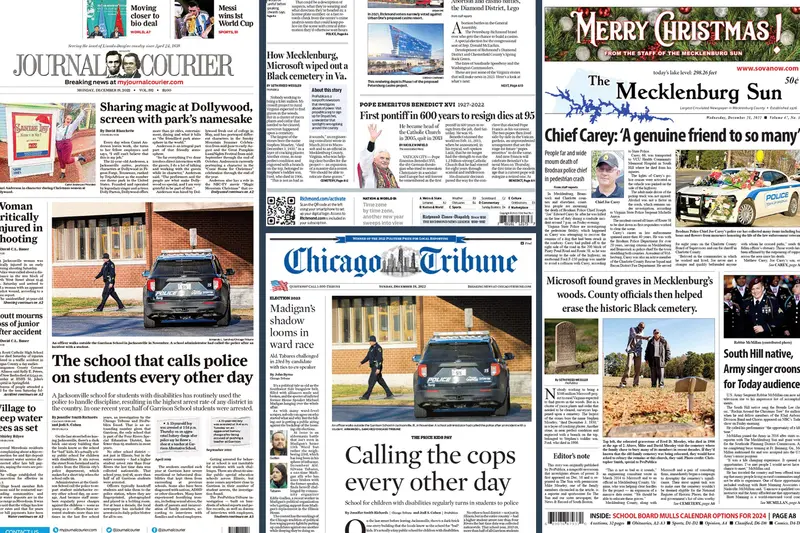Getting The News Articles To Work
Table of Contents4 Easy Facts About News Articles DescribedWhat Does News Articles Mean?News Articles for BeginnersFascination About News ArticlesIndicators on News Articles You Need To Know
Excellent expertise of various subjects provides pupils a competitive side over their peers. Although electronic and social media are easily available, we should not neglect exactly how important it is to read the newspapers. Parents must attempt and instill the habit of reading a newspaper as a day-to-day routine to proceed the heritage of the revered print medium.Newspaper article additionally have a minimum of one of the adhering to vital characteristics about the intended audience: closeness, importance, timeliness, human passion, oddity, or repercussion. The relevant term journalese is often used, usually pejoratively, to describe news-style writing. An additional is headlinese. Newspapers usually stick to an expository writing style.
Within these limitations, news tales also aim to be thorough. Various other variables are entailed, some stylistic and some derived from the media form. Among the larger and a lot more recognized newspapers, justness and equilibrium is a major variable in providing info. Commentary is typically restricted to a separate area, though each paper may have a different overall angle.
Newspapers with a worldwide target market, as an example, often tend to make use of an extra official design of composing. The certain options made by a news outlet's editor or editorial board are commonly accumulated in a style guide; common design overviews include the and the US News Style Book. The main objectives of news writing can be summed up by the ABCs of journalism: precision, brevity, and quality.
Getting My News Articles To Work
As a regulation, reporters will not utilize a lengthy word when a brief one will certainly do. Information authors try to avoid using the very same word more than as soon as in a paragraph (occasionally called an "echo" or "word mirror").
Headlines often omit the subject (e.g., "Leaps From Boat, Catches in Wheel") or verb (e.g., "Pet cat woman fortunate"). A subhead (likewise subhed, sub-headline, subheading, subtitle, deck or dek) can be either a subservient title under the major headline, or the heading of a subsection of the short article. It is a heading that comes before the main text, or a group of paragraphs of the major text.

of a write-up topic, informant, or interviewee), it is described as a drawn quote or draw quote. Additional billboards of any one of these types might appear later on in the post (especially on succeeding web pages) to lure further reading. Journalistic sites often utilize computer animation methods to swap one signboard for one more (e.g.
News Articles Fundamentals Explained
Such billboards are likewise made use of as pointers to the post in various other sections of the magazine or website, or as ads for the piece in various other publication or sites. News release of the Swiss federal government. Normal structure with title, lead paragraph (summary in strong), other paragraphs (information) and get in touch with details.

Example of a hard-lead paragraph NASA is proposing another space job. The budget plan demands roughly $10 billion for the task.
An "off-lead" is the 2nd most crucial moved here front web page information of published here the day. To "hide the lead" is to start the short article with background info or information of secondary importance to the readers, requiring them to review more deeply into a write-up than they should have to in order to discover the vital factors.
The 9-Minute Rule for News Articles
Typical usage is that a person or more sentences each develop their very own paragraph. Reporters normally describe the company or framework of an information tale as an inverted pyramid. The crucial and most interesting elements of a tale are put at the beginning, with supporting information complying with in order of reducing importance.
It permits individuals to check out a topic to only the deepness that their inquisitiveness takes them, and without the imposition of details or nuances that they can consider unnecessary, but still making that info available to a lot more interested readers. The inverted pyramid framework likewise allows write-ups to be trimmed to any arbitrary length during layout, to suit the space offered.
Some writers start their you can find out more tales with the "1-2-3 lead", yet there are lots of type of lead readily available. This style invariably starts with a "5 Ws" opening up paragraph (as defined above), followed by an indirect quote that serves to support a significant aspect of the very first paragraph, and then a straight quote to support the indirect quote. [] A twist can describe numerous points: The last story in the information broadcast; a "happy" tale to end the show.
Longer posts, such as magazine cover short articles and the items that lead the inside areas of a paper, are called. Feature stories vary from straight news in a number of means. Foremost is the lack of a straight-news lead, a lot of the moment. Rather than offering the significance of a tale in advance, function authors might attempt to draw readers in.
News Articles Can Be Fun For Everyone
The reporter often details communications with interview topics, making the item much more personal. A function's initial paragraphs commonly connect an intriguing moment or event, as in an "unscientific lead". From the details of an individual or episode, its sight swiftly widens to generalities about the tale's topic. The section that indicates what an attribute has to do with is called the or signboard.

The Editor's Toolbox: A Recommendation Overview for Beginners and Professionals (2001) Allan M. Siegal and William G. Connolly. The New York Times Manual of Style and Use: The Official Design Overview Utilized by the Writers and Editors of the Globe's Many Authoritative Newspaper (2002) M. L. Stein, Susan Paterno, and R.